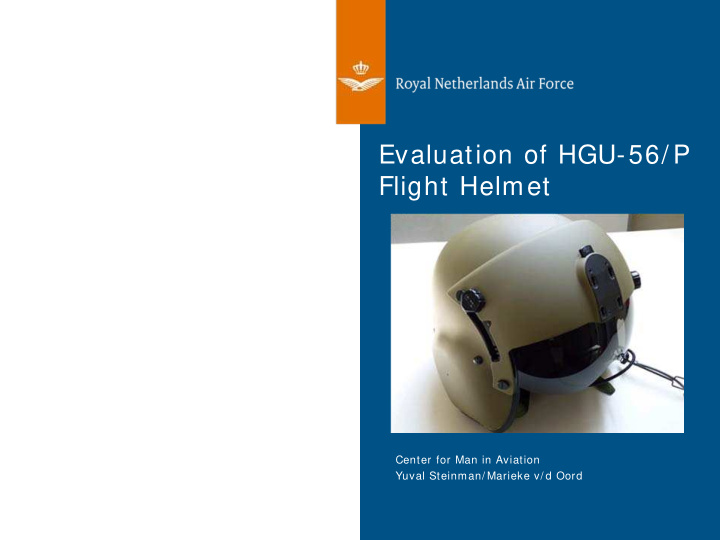



Evaluation of HGU-56/ P Flight Helmet Center for Man in Aviation Yuval Steinman/ Marieke v/ d Oord
Content Introduction Methods Results + Actions taken Ideal helmet Remarks Royal Netherlands Air Force 2 Evaluation HGU 56/ P helmet
Royal Netherlands Air Force 3 Evaluation HGU 56/ P helmet
Introduction Intensive use of the helmet in Afghanistan • Average 4-6 flight hours per week Netherlands • Average 20-24 flight hours per week Afghanistan Increase in complaints about helmet • Stability • Comfort • Inner liner (hot spots) • NVG • CEP (Communication Ear Plug) • Ear cushions Royal Netherlands Air Force 4 Evaluation HGU 56/ P helmet
Methods • Questionnaire • Stability • Ease of use • NVG • CEP • Inner liners • Visor • Ear cushions • Interviews • Manuals • Noise attenuation • Ergonomic research • Future development Royal Netherlands Air Force 5 Evaluation HGU 56/ P helmet
Results I Fit & Comfort, Inner liners, Ear cushions, Stability • Dissatisfaction about helmet fit and comfort –Unclear fitting process – Inadequate helmet fitting • Helmet instability • Hot spots • ~ 50% reported helmet as being “quite heavy” • No ventilation (warm) • Ear cushions • Insufficient helmet sizes • Complaints about the Thermo Plastic liner (TPL) • ~ 50% uses uncertified ZetaLiner Actions: introduction new fitting process, testing new innerliners Royal Netherlands Air Force 6 Evaluation HGU 56/ P helmet
Interviews Example stability: “I started with a helmet one size larger and after 1,5 years, i got one size smaller. When i was flying with the larger helmet, i needed much more counterweights just to keep the helmet in place, now i could do without a CW (… ) although it is still more comfortable to use a CW because of the better weight distribution, but i do not need it anymore to keep my helmet in place” (LM03) Example comfort: “The helmet wants to turnover no matter how much you tighten the napestrap. OK, it helps a little to tighten the napestrap, but if you really tighten it , it feels awkward in your neck, so that is really no option”( lm10) Royal Netherlands Air Force 7 Evaluation HGU 56/ P helmet
Bottlenecks • Edge of absorber liner • Nape strap / retention system • Restricted head movement with snug fit nape strap • Non-symmetric pressure ear cushions • Visor down with NVG not possible Royal Netherlands Air Force 8 Evaluation HGU 56/ P helmet
Results II User friendliness/ Ease of use • Good • Visors easy to use • Problems with boom mic • Problems with chinstrap • Bad protection against dust • Abstraction visual field (sides) • Actions: change of chinstrap and visors Royal Netherlands Air Force 9 Evaluation HGU 56/ P helmet
Results III Noise attenuation Attenuation of the HGU-56/ P alone and in combination with custom molded earplugs and Vented CEP Table 2 noise exposure of the loadmaster under the helmet in the Chinook (back of the Chinook) (111 dBA). 125Hz 250Hz 500Hz 1kHz 2kHz 4kHz 8kHz LAeq Gentex user fit 73 83 80 74 70 71 67 8 6 Gentex user fit + V-CEP+ custom earplug 64 69 65 70 61 54 52 7 4 Gentex expert fit 70 80 78 73 68 65 55 8 3 Gentex expert fit + V-CEP+ custom earplug 64 69 65 71 60 51 50 7 5 Royal Netherlands Air Force 10 Evaluation HGU 56/ P helmet
Vented CEP + custom molded earplugs Royal Netherlands Air Force 11 Evaluation HGU 56/ P helmet
Results IV Noise attenuation, speech intangibility and CEP •Single hearing protection -Insufficiant noise attenuation • Adequate helmet fitting improves attenuation •Double protection (HGU-56P+ CEP)- sufficient attenuation •CEP-Good speech intelligibility •Complaints comfort CEP •Action: • Better helmet fitting • integration of CEP in custom molded earplugs Royal Netherlands Air Force 12 Evaluation HGU 56/ P helmet
Results V Ventilation • inadequate ventilation • Uncomfortably warm • “the feeling of decrease in performance” • Proposal: research other inner liners for improved cooling , air cooling for helmet • Ongoing research- comparison of different inner liners Royal Netherlands Air Force 13 Evaluation HGU 56/ P helmet
Results VI Night Vision googels • Poor stability • Use of counterweights (CW)- 200-400g • Stability improvement • Decrease in neckload • Total configuration helmet+ NVG+ CW= heavy Action: integration of NVG into fitting process • Improve stability • Improve comfort? • Decrease neckload? Royal Netherlands Air Force 14 Evaluation HGU 56/ P helmet
Ideal flight helmet according to aircrew I • Task related factors –No obstruction of the visual field –Protection of face, eyes, head and hearing –Good communication possibilities –Won’t cause any head movement constraints • User related factors –Good thermoregulation properties –Good fit and size options –Stability and no gliding of the helmet –Weight as less as possible –One unit in all configurations / compatibility –Not causing any discomfort –User friendly Royal Netherlands Air Force 15 Evaluation HGU 56/ P helmet
Ideal flight helmet according to aircrew II Not being aware of wearing a helmet Royal Netherlands Air Force 16 Evaluation HGU 56/ P helmet
Remarks The new helmet fitting procedure improved • Helmet stability with and without NVG • Noise attenuation What is the influence of improved fitting on comfort? Research into other innerliners to improve helmet ventilation Royal Netherlands Air Force 17 Evaluation HGU 56/ P helmet
Questions Royal Netherlands Air Force 18 Evaluation HGU 56/ P helmet
Recommend
More recommend